Within the SUP experience there are 2 variables which directly shape your interaction with the water. Your board and your paddle. Both of which are highly debated and personal topics that can get very heated at a moment notice. Talking about what style of board you prefer, or your paddle choice is almost like talking about religion or politics at a family dinner party. Paddlers will defend and argue their choices with fervor of a brand-new politician.
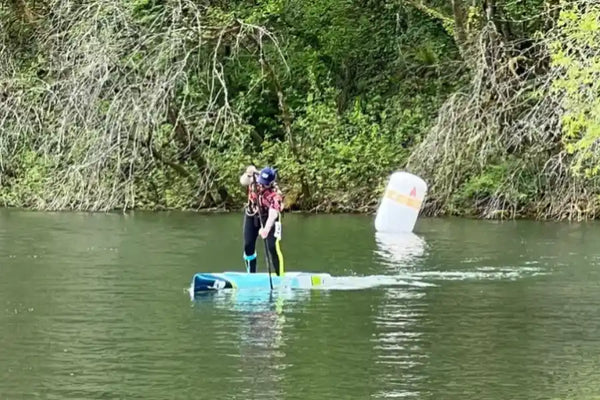
Okay, so maybe it is not that serious. Maybe just maybe I am being a little over dramatic. All and all it is quite enjoyable to talk gear with our fellow paddlers. For this article we are going to focus on Recreational and Racing paddles. Although the characteristics are similar, whitewater and surf paddles have slightly different requirements.
So, let’s talk about paddles…
Let’s start with what is a paddle and what is it for? A paddle at its most basic level is essentially a tool that allows us to grab onto the water and use our bodies energy to propel our boards forward. In an ideal situation we place the paddle in the water and drive our boards past it with the paddle staying in the same place we put it at “The Catch” of the stroke.

What does a paddle need to do?
As mentioned above a paddle needs to hold its place when placed in the water relatively well. This is its main job from the catch through the power phase of the SUP stroke. After the power phase ends it needs to have the ability to exit the water cleanly and return to the catch while conserving as much energy as possible in what is known as the recovery phase of the stroke.
First, we need to talk about blade size. SUP paddle blade sizes range from around 72 square inches to 96 square inches of surface area. Generally speaking, if you are a larger paddler you will likely be able to handle a larger blade size. You will have more body mass to power that blade.

If you are a smaller paddler you may not have the mass to power the larger blade so a smaller one may be a better choice. This is not a perfect science. There is a lot of personal preference here. 5 or so years ago people were attempting to use the biggest blade they could. On the surface this makes sense since a larger blade is going to grab the water “better”.
However, this “better” grab also requires a higher energy output to maintain over time. So, it can lead to fatigue earlier. Great if you are only going a short distance, not so great if you must keep going for a longer period of time. In SUP not only are the boards shrinking but so are the paddles. The current trend in SUP racing seems to be a smaller blade size than it was 5 years ago.

With the changes in stroke technique and blade shapes we have seen in recent years, the smaller blade sizes seem to be the more popular choices. Again, a lot of this is personal preference. There are still elite racers out there that continue to prefer the feel of a larger blade.
Second, we need to talk about getting shafted. Yep it is time to get personal and ask how long should your shaft be? Once again there is a lot of personal preference here. Generally speaking, the go to now is between 4 to 12 inches above your head. Have a listen to what 4x Molokai Champion Travis Grant has to say about paddle length:
A few other things to consider, if you are riding a thicker board which you will sit higher off the water you will need a little extra length. If you are paddling a dugout-style board, you may choose to use a much shorter length paddle.
You also will want to consider what type of paddling you are doing; a recreational paddler will likely have a more enjoyable experience with a paddle that is a little longer, due to the less aggressive body position needed to get the paddle in the water.

For a racer it will be about finding a balance. Too long and your shoulders will feel it, too short and your back may fatigue due to a compensating posture. A great starting option is to use an adjustable length paddle and play with different lengths and see what feels right to you. Personally, I simply started my fixed length paddle at the longer end of the spectrum and have continued to trim it down. It is currently about 6 inches above my head and while paddling the 22.5 Carolina it seems pretty good.
These two variables are not mutually exclusive. The paddle size and the length interact with each other in a huge way. Good ol' physics time. Paddling is about controlling load and levers. Paddling is what would be considered a "3rd class lever” Just like a really big shovel with a really long handle would be hard to lift. when loaded a larger blade with a longer shaft will require more energy than a smaller blade with a shorter shaft.
This is why Outrigger canoes and other paddling sports can have much larger blade sizes. Since they are seated the paddle shaft is naturally much shorter. So basically, I just ended an age old argument... Size and length do matter!
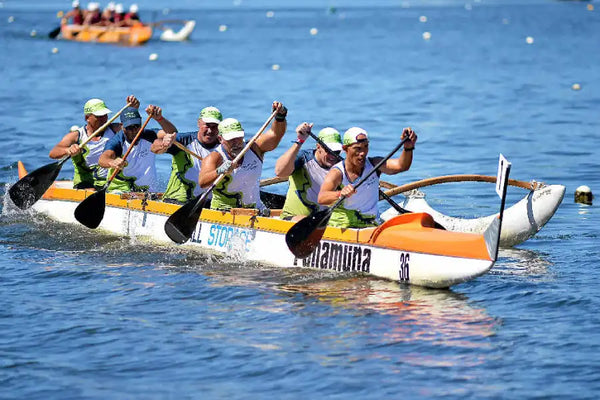 Those outriggers rely on some hefty surface blades
Those outriggers rely on some hefty surface blades
The next major variable in how a SUP paddle will feel is weight. This is a little more of a simple answer however still a lot of personal preference will come into play. Generally lighter is better to an extent. A lighter paddle will require less energy to get out of the water, less energy during the recover, and less energy getting back in at the catch.
However, I have heard many paddlers comment on a paddle feeling too light. Having a little weight, allows our bodies to know where the paddle is at all times. For some people this is more important than others. Speaking anecdotally a newer or recreational paddler may benefit from having a paddle with a little bit more weight to it.
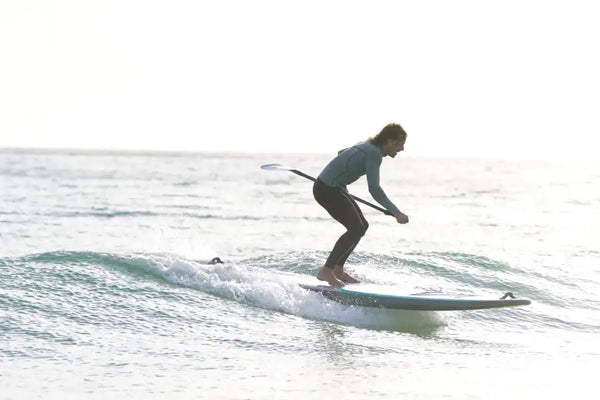
I am not talking heavy here, just a little more feel to the paddle, allowing you to know where it is while in- and out of the water. Once you feel comfortable with your paddle and your technique is refined, it might be time to go ultra-light.
The last variable that most average paddlers will notice is blade shape. In the last few years, two predominant blade shapes seemed to have taken over. Firstly, the traditional more teardrop-shaped paddle.
A good example of this shape can be seen in the Carbon Speedster 86 and Speedster 81 paddles. This is a classic shape that has been around for quite some time. This shape tends to promote a solid and easy catch with an early load up and allows for a little more wiggle room if you do not get your blade all the way into the water. This is due to the wide point being at or near the bottom of the blade.
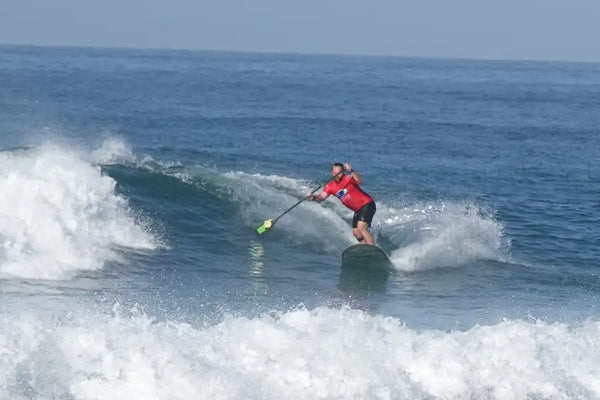
Kieran Plim about to balance out with the help of his 100% Carbon Speedster 81
The next dominating shape is a paddle with more parallel outline such as seen below in the Carbon Speedster 76 paddle. This shape also loads up quick and in my opinion does require the paddler to make sure the paddle is fully submerged in the water.
This can make them a little less forgiving to technique shortcomings. During the power phase of the stroke, these smaller surface blades continue to hold the load well and exit the water very clean allowing for a quick recovery.
Due to the placement of the surface area, these paddles are generally a little smaller than the more traditional teardrop paddles mentioned earlier.
Okay, now we are going to get into the nuances that in my opinion are much more heavily preference and performance paddling driven.
First, shaft stiffness. Stiffer is not always better. Especially for a recreational paddler. A paddle with little give is great when you are at your peak fitness and all you care about is speed. However, we must understand that energy has to go somewhere and a portion of it is going to be “absorbed” by our bodies. Specifically, our joints. For most of us, the stiffest lightest paddle may not be the best choice for our bodies long term.
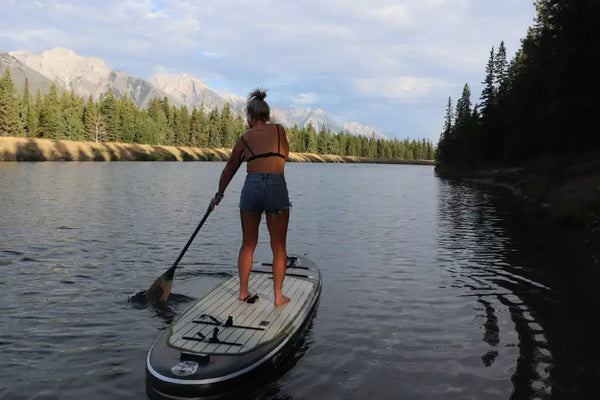 Going the distance is best done with a comfortable paddle
Going the distance is best done with a comfortable paddle
Next are blade contours and curves. Each brand of paddles seems to have their own proprietary blade contour or curve with a fancy name. This is where I say, try it. See how it feels to you. Demo multiple paddles in a row. Did your board speed change for the better? Did you feel like paddling was easier? If yes maybe it is legit for you. I have demoed several paddles from big brands. If I am being truly honest, I have not noticed a huge difference in all the fancy talk. Maybe I just am not a good enough paddler to notice?
Closing thoughts:
Size, Length, Weight and Shape are going to be the variables that will be the most noticeable to the average paddler. An adjustable paddle is not a bad place to start. I believe everyone should have one around just so your friends can paddle with you. When moving to a fixed length paddle start at the longer end of your range. You can always make a fixed paddle shorter it is much harder to make them longer again. Take 'em down in increments.
As with all things paddling the best way to know what is going to be your best paddle is by trying them out. Most shops will regularly organize paddle demos.
For more information on all of NSP Paddles and a quick guide to sizing your paddle, head over to the International NSP website.

Ted Schatz is a college professor who teaches Exercise Science, Health, and Physical Education and is a self-proclaimed “movement geek.” He found SUP through his love of all things water-related and his passion for breaking down skills and movements.
He is a Pacific Northwestern to his bones from rain in his veins and moss on his back type. In addition to that, he works at Gorge Performance, regularly sneaking out three paddles at once to compare.




